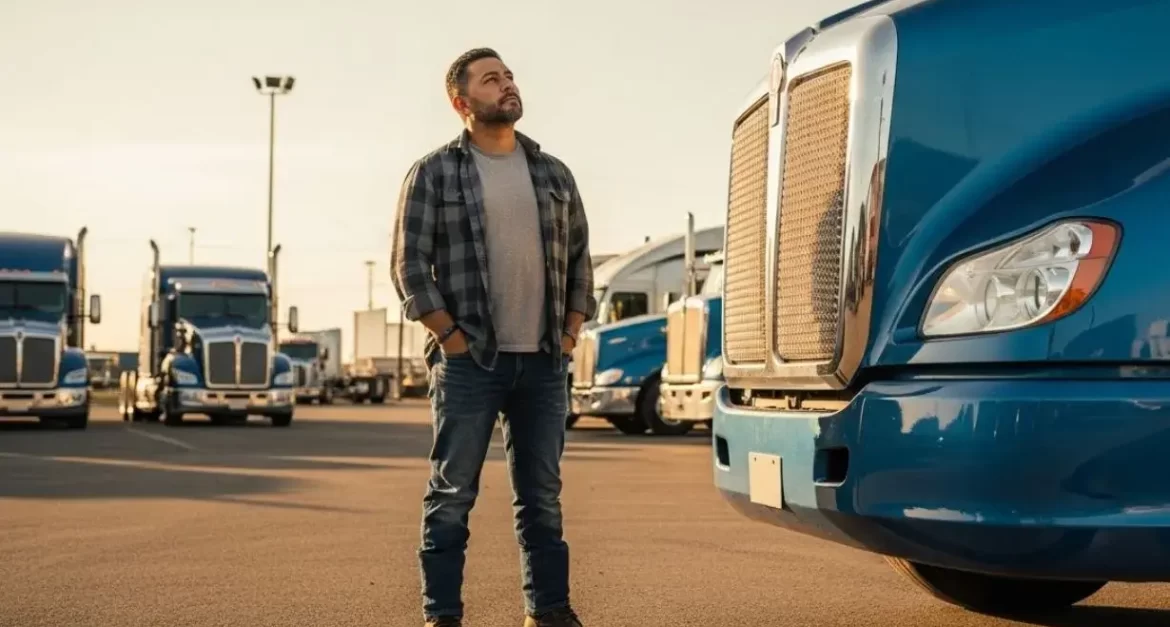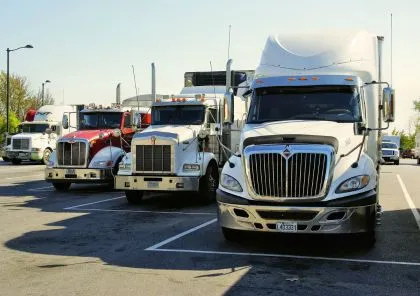
Follow us on youtube for more valuable content:
The rumble of the engine, the endless ribbon of highway, the freedom of the open road – for many truck drivers, these are the daily realities of the job. But for some, there’s a deeper dream simmering just beyond the horizon: the dream of becoming an owner-operator. It’s the ultimate expression of independence in the trucking world – your own rig, your own rules, your own business. But before you can be your own boss, you need to tackle the first major hurdle: getting your hands on a truck.
The journey to truck ownership can feel like navigating a maze of financial options, each with its own set of twists and turns. It’s a decision that can make or break your new venture, so it’s crucial to understand the road ahead. This guide will be your co-pilot, helping you navigate the different paths to acquiring your first truck and steer clear of the common potholes that can send your dreams careening into a ditch.
The Big Three: Unpacking Your Truck Acquisition Options
When it comes to getting your first truck, there are three main routes you can take: financing, leasing, and lease-purchase programs. Let’s break down what each of these means for you, your wallet, and your future as an owner-operator.
Financing: The Traditional Path to Ownership
Think of financing a truck like getting a mortgage for a house. You take out a loan from a bank, credit union, or specialized equipment financing company to cover the cost of the Purchase. You then make regular payments over a set period until the loan is paid off. Once you’ve made that final payment, the truck is all yours – title and all.
The High-Fives of Financing:
- You’re Building Equity: Every payment you make is an investment in your business. Once the truck is paid off, it becomes a valuable asset that you can sell or use as collateral for future investments.
- Freedom and Flexibility: It’s your truck, so you can customize it, run as many miles as you want, and take on any loads you choose (within legal limits, of course).
- Potential Tax Advantages: You may be able to deduct the interest on your loan and depreciation on the truck, which can be a nice bonus come tax time.
The Headaches of Financing:
- High Upfront Costs: Lenders typically require a significant down payment, often between 10% and 25% of the truck’s price. For a new rig, that can be a hefty chunk of change.
- Tough Credit Requirements: Getting approved for a commercial truck loan usually requires a good credit score and a solid financial history.
- You’re on the Hook for Everything: From routine maintenance to major repairs, all the costs of keeping your Truck and Trailer on the road fall on your shoulders.
Leasing: A Lower-Cost Entry Point
If the upfront cost of financing gives you sticker shock, leasing might seem like a more attractive option. When you Lease a truck, you’re essentially renting it for an extended period, typically two to five years. You make monthly payments to the leasing company, and at the end of the term, you usually have the option to return the truck, renew the lease, or sometimes, buy the truck.
The Perks of Leasing:
- Lower Initial Costs: Leases often require little to no down payment, making it easier to get into a truck and on the road.
- Newer, More Reliable Equipment: Leasing companies often offer the latest models, which means better fuel efficiency and fewer maintenance headaches.
- Predictable Monthly Payments: Your monthly lease payment is a fixed cost, which can make budgeting easier for a new Owner Operator.
The Pitfalls of Leasing:
- No Equity: You’re essentially paying for the right to use the truck, but you’re not building any ownership in it.
- Mileage Restrictions: Most leases come with a cap on the number of miles you can drive. Exceed that limit, and you’ll face hefty penalties.
- Less Freedom: The leasing company owns the truck, so you’ll likely have restrictions on customizations and how you can use the vehicle.
Lease-Purchase: A Hybrid with Potential Pitfalls
Lease-purchase programs, often touted by trucking companies, can seem like the best of both worlds. You lease a truck for a set period with the intention of buying it at the end of the term. A portion of your monthly payment goes toward the purchase price of the truck.
While this can be a legitimate path to ownership for some, it’s also a road littered with potential dangers. These agreements are often complex and can be structured in ways that benefit the company more than the driver. It’s one of the most common areas where aspiring owner-operators run into trouble, making it a hotbed for Common Mistakes.
The Allure of Lease-Purchase:
- Path to Ownership for Those with Bumpy Credit: These programs are often marketed to drivers who can’t qualify for traditional financing.
- Often Tied to a Carrier: This can mean consistent work, at least initially.
The Red Flags of Lease-Purchase:
- Inflated Truck Prices: The purchase price of the truck is often set much higher than its actual market value.
- Unfavorable Terms: You may be locked into a contract with high weekly payments, a large balloon payment at the end, and no way out without losing everything you’ve paid in.
- The “Fleece” Purchase: A term coined by drivers, this refers to predatory lease-purchase programs where the carrier sets the driver up to fail, only to reclaim the truck and lease it to the next hopeful.
A Fork in the Road: Less Common Acquisition Paths
While the “big three” are the most common routes, there are a few other paths you might consider:
- Buying Outright: If you have the cash, buying a truck outright is the simplest option. You’ll have no monthly payments and complete freedom.
- Auctions: Government and fleet auctions can be a great place to find a good deal on a used truck. However, it’s a “buyer beware” situation. You’ll need to do your homework and be comfortable with the risk.
- Assuming a Lease or Loan: You can sometimes take over another driver’s existing lease or loan. This can be a good option if you can find a favorable contract, but you’ll need to have the original agreement thoroughly reviewed.


At-a-Glance Comparison: Choosing Your Path
To help you visualize the differences, here’s a quick comparison of the three main acquisition methods:
| Feature | Financing | Leasing | Lease-Purchase |
|---|---|---|---|
| Initial Cost | High (down payment required) | Low (often no down payment) | Varies (can be low, but watch for fees) |
| Monthly Payments | Generally higher | Generally lower | Can be high and tied to carrier revenue |
| Equity | Yes, you build ownership over time | No, you are renting the asset | Potentially, but often with unfavorable terms |
| Maintenance | Your responsibility | Often covered by the leasing company | Your responsibility |
| Freedom & Flexibility | High | Low (mileage and usage restrictions) | Low (often tied to a specific carrier) |
| Ideal Candidate | Financially stable, good credit | Wants lower risk and newer equipment | Has poor credit and limited options |
Navigating the Potholes: Common and Less-Obvious Mistakes to Avoid
The road to becoming a successful owner-operator is paved with good intentions, but it’s also full of potential pitfalls. Here are some of the most common and less-obvious mistakes to watch out for:
Financial Missteps:
- No Business Plan: “Winging it” is not a business strategy. You need a solid business plan that outlines your expected income, expenses, and a roadmap for growth.
- Underestimating Operating Costs: Fuel, insurance, maintenance, tires, permits, and taxes can add up quickly. A good rule of thumb is to have at least three to six months of operating capital saved up.
- The Balloon Payment Trap: Some loans and lease-purchase agreements come with a large, final “balloon” payment. If you’re not prepared for it, you could lose your truck and everything you’ve invested.
Equipment Errors:
- The Wrong Truck for the Job: Buying a gas-guzzling, high-maintenance rig might seem like a good deal upfront, but it can eat into your profits down the road.
- Skipping the Pre-Purchase Inspection: Never, ever buy a used truck without having it thoroughly inspected by a trusted, independent mechanic. A detailed inspection can save you from a world of expensive headaches.
- Contractual Traps:
- Not Reading the Fine Print: This is arguably the biggest mistake you can make. Read every word of your financing or lease agreement. If you don’t understand something, ask a lawyer who specializes in trucking contracts to review it.
- The “No Credit Check” Siren Song: Be extremely wary of any deal that promises a truck with no credit check. These are often predatory lease-purchase programs in disguise.
Fueling Your Dream: Financial Prep for the Long Haul
Becoming an owner-operator is about more than just driving a truck; it’s about running a business. Here’s how to get your financial engine humming:
- Build Your Business Credit: Start by registering your business and getting an Employer Identification Number (EIN). Then, open a business bank account and consider getting a business credit card to start building a credit history that’s separate from your personal finances.
- Create a Watertight Business Plan: This is your roadmap to success. It should include a detailed budget, a market analysis, and your plans for finding freight.
- Secure Your Operating Capital: Don’t start your business on fumes. Having a healthy cash reserve will help you weather the inevitable slow periods and unexpected expenses.
Your Rig, Your Rules, Your Future
The journey to becoming an owner-operator is a challenging one, but it’s also incredibly rewarding. By understanding the different paths to truck ownership, being aware of the common pitfalls, and preparing yourself financially, you can turn your dream of independence into a profitable reality.
The road ahead may be long, but with the right knowledge and a healthy dose of caution, you can confidently take the wheel of your own destiny. So, do your homework, trust your gut, and get ready to enjoy the view from the driver’s seat of your very own business. The open road is calling – are you ready to answer?
FAQ for Your First Truck: Lease vs. Financing vs. Lease-Purchase
1. What is the minimum credit score I need for truck financing?
2. How much money do I actually need to start my owner-operator business?
Insurance down payments ($3,000 - $5,000)
Permits, licenses, and authority fees ($1,000 - $2,500)
A maintenance fund for unexpected repairs
Fuel and daily living expenses on the road for several weeks
Running out of cash in the first six months is a primary reason new ventures fail. Don't start on empty!
3. Should I buy a new or used truck?
New Truck: You get the latest technology, better fuel efficiency, and a manufacturer's warranty, which means fewer unexpected repair costs. However, the initial purchase price and monthly payments will be much higher.
Used Truck: The upfront cost is significantly lower, leading to smaller loan payments. The trade-off is a higher risk of maintenance issues and no warranty coverage. If you go this route, a thorough, independent pre-purchase inspection is non-negotiable.